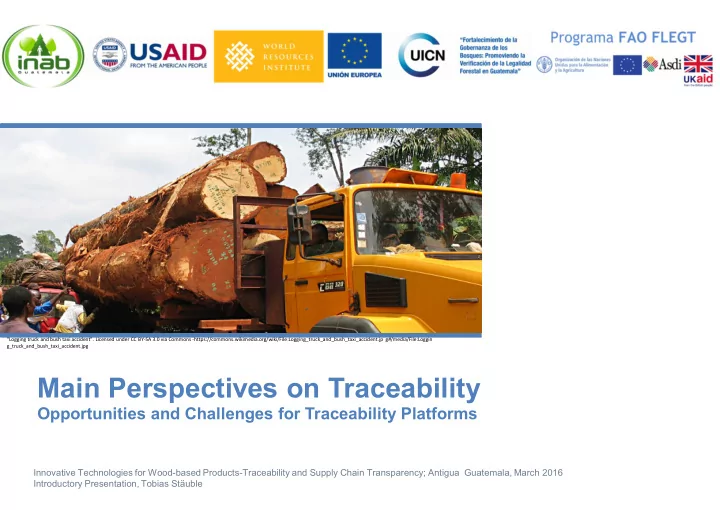

"Logging truck and bush taxi accident". Licensed under CC BY-SA 3.0 via Commons -https://commons.wikimedia.org/wiki/File:Logging_truck_and_bush_taxi_accident.jp g#/media/File:Loggin g_truck_and_bush_taxi_accident.jpg Main Perspectives on Traceability Opportunities and Challenges for Traceability Platforms Innovative Technologies for Wood-based Products-Traceability and Supply Chain Transparency; Antigua Guatemala, March 2016 Introductory Presentation, Tobias Stäuble
Ok, you have seen this a thousand times, but once again: Be conscious of the diversity of our sector in terms of material and supply chain Forests and Plantations – legal and illegal harvest characteristics and keep this in mind during the Logs Logs Logs next two days! Exchange of semi-finished products and pre-consumer material between different mills Veneer/Plywood Boardmill Pulp Mill Paper Mill Fuelwood Sawmill Flooring Primary Processing Log Input and Other Input Primary Processing only Log Input Pre-consumer Pre-consumer Post Consumer 2nd Process Energy Plant Introduction Slide
The Producer Side Perspective example scope of tracking system Natural Resource An underlying objective of tracking and tracing Level systems in forestry is to enhance responsible resource use. Downstream/Tracking Monitoring the resource base can be complemented (further incentive, royalty Primary Processing collection) and strengthened by tracking systems. Scope of these is necessarily limited e.g. by the national border. Material flow needs to be captured as Secondary comprehensively as possible. Processing Mass balancing at different Critical Control Points (e.g. Road Bottlenecks, Mill Gates) can confirm that sustainable harvest in the monitored resource base was not exceeded. Trade/Retail Under which conditions will tracking systems enhance responsible resource use? Comprehensiveness? Dynamics? Consumer End How can Traceability Platforms help to create these conditions?
The Consumer Side Perspective Traceability systems help to manage claims Natural Resource Level on (finished) products. Tracing back one single unit shall verify Downstream/Tracking claims on this unit (claims are time bound!) Primary Processing Upstream/Tracing The more often the consumer side asks for verification of claims, the more false claims will be uncovered (given the system works reliably). Secondary If there are consequences when tracing Processing uncovers false claims, increased use of traceability systems will drive responsible resource use. Example tracing of a product Trade/Retail Will consumer behaviour and other demand side actors drive the uptake of traceability platforms? Consumer End
The Role of Traceability Platforms Traceability is time consuming and costly. An important factor Natural Resource Level are information availability and data management. Downstream/Tracking Traceability platforms as centralized data management Traceability Platform Primary Processing Upstream/Tracing solutions can mitigate the cost of traceability, enhance data availability (and dynamics), thus increasing the benefits of a traceability system. Secondary Processing Verifying a product claim (e.g. on species and origin) via querying a traceability platform is one approach among several Trade/Retail (DNA, Stable Isotopes…) Which criteria define the status of data derived from a system in the perspective of Consumer End different actors?
Traceability System Design and Governance Traceability to the scope limit Natural Resource Level of an acknowledged tracking system – a minimum requirement for traceability Downstream/Tracking systems? Traceability Platform Primary Processing Upstream/Tracing What could be a governance structure for traceability systems, that respects the needs of all users? (e.g. deliver reliable Secondary Processing information, cover internal traceability, maintain confidentiality, provide necessary transparency…) Trade/Retail How can traceability platforms facilitate the development of such structure? Consumer End
Recommend
More recommend